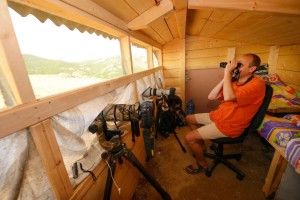This October, Rewilding Rhodopes organized a special training course on the management and development of wildlife watching enterprise and wildlife photography in Madzharovo, Bulgaria. The training was part of the LIFE Project “Conservation of black and griffon vultures in Rhodope Mountains” (LIFE Vultures), and connected more than 30 participants that gained valuable knowledge, exchanged experiences and ideas.

 Local Bulgarian tour operators, owners of birdwatching hides and guesthouses, professional nature guides and wildlife photographers, living in and around Rhodope Mountains rewilding area, gathered for an extensive training course to learn about best practices for operating a wildlife watching business. The training was part of LIFE Vultures project, includes the support of developing new wildlife watching enterprises in the area.
Local Bulgarian tour operators, owners of birdwatching hides and guesthouses, professional nature guides and wildlife photographers, living in and around Rhodope Mountains rewilding area, gathered for an extensive training course to learn about best practices for operating a wildlife watching business. The training was part of LIFE Vultures project, includes the support of developing new wildlife watching enterprises in the area.

Carles Santana, a wildlife-watching expert from Spain, gave this special course where he shared his experience from Spain. He also provided general ideas for creating better enterprise opportunities in Rhodope area. His course focused on the design, functionality and management of wildlife hides. Santana and his partner are now running a small but profitable business in Spain; currently their company manages 70 out of all 500 functioning wildlife watching hides in Spain. These 70 hides are positioned in ten different locations throughout the country – from the coastline to the interior, even including one in Barcelona. Their project, “Iberian wildlife photography network”, is part of the European Rewilding Network (ERN).
At the beginning, Santana launched his company with only one hide but soon realized that in order to be successful, the company needed to offer a well thought-over product in different locations with a variety of species to wildlife photographers and watchers. The design and construction of hides he built since then, depend on specific uses, so he developed various types: from floating platforms to above the ground constructions. The common trait all hides share is the sensitivity to environment, the hides allow for wildlife watching without disturbing it. The company works with many non-governmental organizations, local authorities, landowners and other interest groups. A number of hides is located on agricultural land, whose owners receive a fair share of the profits. Currently Santana manages a team of ten people, mostly freelance wildlife photographers and guides.
At the course, Santana shared with the participants what he considers one of the key success factors for site selection: “Good selection of the location is one of the key factors however more important are the people as they need to be totally devoted to their work. During training in Madzharovo I met highly motivated and willing people”.

Santana took the opportunity to visit the area and enjoy the high diversity of birds and other animals in the area. “The Rhodope Mountains have a huge potential of becoming an exceptionally popular European wildlife photography destination. For this to happen, it is necessary to build more hides allowing watching and photographing a greater variety of species”, he recommends.
During the course, Marin Kourtev, a local operator interested to expand his business with wildlife watching and photography, shared the Bulgarian experience and commented: “What was very useful about this training is that we once again realized how important is to work together. Otherwise it is very difficult to offer a competitive product”.
Hristo Hristov from Rewilding Rhodopes made a presentation about how to avoid risks that vulture feeding may pose to birds and humans. Currently tree hides in the eastern part of the Rhodope Mountains provide opportunities to photograph different bird species while feeding goes on year-round. The hides are specially designed for observing and photographing vulture species – griffon, black and Egyptian vulture, as well as some other birds of prey like golden eagle, Eastern Imperial Eagle, white-tailed eagle and black kite. Occasionally wolf, red fox and other animals are also spotted in the area.
The Rhodope Mountains have the potential to become a wildlife tourism destination since the region is extremely rich in terms of biodiversity. However, the potential of wildlife tourism development remains largely untapped. Our hope is that with the increase of the number of annual visitors coming to the area, sustainable wildlife watching activities will extend the tourism season and provide a new source of income to the local people.
Keep watching our safari-page which already offers trips to this and other rewilding areas, with more to come!
